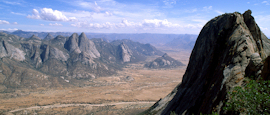Eritrea Weather, climate and geography
Weather & climate
There is no time of year that is particularly unsuitable for visiting Eritrea. The country can be divided into three major zones: the central highlands, the coastal region, and the western lowlands. Each has a different climatic pattern.
In the highlands, the hottest month is usually May with highs around 30°C (86°F). Winter is between December and February with lows at night that can be near freezing and dramatic temperature differences between day and night. Asmara itself enjoys a pleasant climate all year round. There are two rainy seasons: the short rains in March and April and the main rains from late June to the beginning of September. These are unlikely to impede travel or general enjoyment of the highlands.
On the coast, the months from June to September are extremely hot with daily temperatures ranging from 40°C (100°F) to 50°C (122°F) (and hotter in Dankalia). In winter the daily temperature ranges from 21°C (70°F) to 35°C (95°F). This is a good time to visit, when it is not insufferably hot and skies are invariably clear. It is always warm enough to swim, even in the winter months of February to April, which can be cloudy. The rainy season on the coast north of Dankalia falls in the winter months; in Dankalia itself, rain is extremely rare.
In the western lowlands, the high temperatures are comparable to those on the coast in the hottest months of April until June. December is the coldest month with temperatures falling as low as 15°C (59°F). The rainy seasons are the same as for the highlands.
If you are in the highlands during winter it is advisable to bring at least one set of warm clothes. Otherwise shirts and a couple of pairs of trousers are enough: lightweight cotton for walking, and for wearing in the evening. Despite their limited resources Eritreans are always smartly dressed and even during sandstorms in the lowlands they seem to be able to remain pristine.
Eritrea has a large Muslim population and women should dress with this in mind, not exposing the knees or shoulders. This will avoid a lot of trouble, especially in the lowland areas. Shorts are not generally worn, by men or women, in Asmara or other towns, with the exception of the coast, but obviously if you are travelling in Dankalia or other out of the way areas they are practical. As a general rule, Eritreans dress modestly and you should do the same.
A sunhat is essential on the coast and in the western lowlands, as too are a good pair of sunglasses.
Good walking shoes or boots are essential if you are travelling anywhere other than the major cities. Trainers, flip flops or sandals are all useful, depending on the purpose of your stay.
Geography
Eritrea is a land of extraordinary physical diversity. It is one of the few countries where visitors can truly experience ‘four seasons in a day’.
The eastern lowlands that stretch along the Red Sea for almost 1,000km (625 miles ) offer a stunning variety of scenes, from barren deserts to towering volcanic landscapes. Scattered off the coast and its myriad coral reefs are the 350 islands of the Dahlak Archipelago.
In the north is the border with North Sudan and in the south, Djibouti. The centre of the country comprises the precipitous highland plateau that appears to float in the clouds as you wind up the vertiginous slopes of the escarpment from the coast by road or even steam railway.
At nearly 2,500m (8,200ft) altitude, Asmara is the highest capital in Africa. Much of the southern highlands is agricultural and borders Ethiopia. To the west of Eritrea, the plateau fractures and tumbles into the western lowlands where a desert landscape stretches out across vast plains and meets the border with the north of Sudan.
Do you have any Feedback about this page?
© 2026 Columbus Travel Media Ltd. All rights reserved. No part of this site may be reproduced without our written permission, click here for information on Columbus Content Solutions.




 You know where
You know where